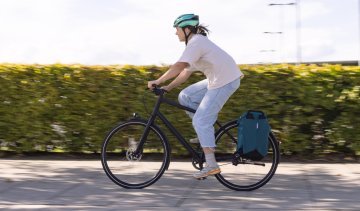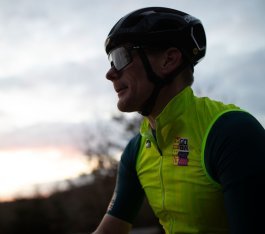
Tyre pressure guide for city, touring & trekking
Find out the optimal tyre pressure for your bicycle tyres and why you’ll roll more easily without sacrificing puncture protection or comfort!
When cycling in the dark, highly visible clothing and accessories are essential. Find out how to properly equip yourself and your bike here.
As soon as summer is over, the days get shorter and the weather worsens, the topic of high-visibility comes into focus. Whether you commute to work by bike, ride with your children to school, or go for a training ride after work: the early darkness in the evening, the late daylight in the morning, or poor visibility due to rain or fog repeatedly lead to tricky situations, especially in autumn and winter, when drivers notice you on your bike very late.
Even if your bike lights are working perfectly and comply with legal requirements, as a cyclist, you are not always noticed in time by other road users. Therefore, the rule is: increase your visibility! Your body is the largest surface you can make visible in traffic. So, focus on eye-catching, bright colours, reflective applications, and additional lights on your clothing, helmet, and bags! These simple measures can make the difference between being seen and being overlooked.
High-vis clothing isn’t mandatory, but it significantly increases your chances of staying safe in traffic. © Wowow
In nighttime traffic, you are visible very late when wearing dark clothing. Drivers often don't spot you until you are only 25 meters or less away – depending on speed and reaction time, this is not enough to swerve or stop in time. If you wear light-coloured clothing, however, the visibility range can be increased to up to 40 meters. Even better: with neon-coloured, reflective clothing and additional reflector elements, visibility increases to up to 160 meters.
Reflective elements on body parts that move while cycling are particularly effective. These movements create the so-called biomotion effect, which helps our brain to recognize much faster that it is a person. This way, you are identified more quickly and clearly as a cyclist.
With a few simple measures, you can therefore enormously improve your safety on the bike (or in traffic in general). Let's get started!
The biomotion effect refers to the fact that moving objects are much easier to recognize. These can be neon-coloured overshoes or the (mandatory) reflectors on your bike’s pedals. © GripGrab
The classic piece of high-visibility gear (also called high-vis or hi-vis) is the safety vest: neon yellow with reflective elements or made entirely of reflective material. Worn over a jacket, the safety vest is suitable for all weather conditions, it's inexpensive, and when you don't need it, you can simply store it in a backpack or bag. Even better than just a vest are neon-coloured, fluorescent hi-vis jackets and trousers with reflective stripes. They are a bit more expensive, but they increase visibility enormously (even during the day) because the entire body is used as a hi-vis surface. You'll need a thermal jacket or raincoat and suitable pants anyway in the dark, cold season to commute or train comfortably. If a neon jacket or trousers are too much for you, you can opt for more subtle colours and ensure there are sufficient and well-placed reflective stripes.
In our range, you will find particularly visible clothing in the hi-vis collections from Endura, Wowow, and others.
The Belgian brand Wowow specializes in high-visibility vests and accessories. © Wowow

High-vis clothing can also be useful for sports cycling – for example, when a training session starts or ends in the dark during autumn or winter. © Gobik
Reflective, neon-coloured shoecovers and gloves are practical aids to increase your visibility on the bike. Since your feet are constantly moving while pedaling, neon-yellow shoecovers with reflective stripes attract a lot of attention in the dark due to the biomotion effect when illuminated by headlights. Fluorescent and reflective gloves also make an important contribution to your safety on the bike: they make your hand signals more visible when turning.
Although helmets are not mandatory for cycling in Germany (except for S-pedelecs), we strongly recommend wearing a bike helmet. In addition, a helmet in signal colours or with LED lighting can significantly increase your visibility on the bike in the dark or in bad weather. If you don't want to buy a new bike helmet, check if you can attach a helmet light to your current model. Alternatively, additional reflective strips, reflective stickers, a brightly coloured helmet cap, or a neon-coloured, reflective helmet cover (some even come with an integrated, rechargeable LED rear light) are also very suitable for making you visible on the bike. A helmet cap and cover also offer you good protection against cold and rain.
The Danish company GripGrab has dedicated itself entirely to the hi-vis theme, and you can find their neon-yellow reflective gloves or overshoes as well as other hi-vis accessories in our range.
High-visibility clothing can be functional without being ugly – the Danish brand GripGrab proves it. © GripGrab
Especially if you commute or manage your daily life by bike, you can specifically use bag(s) and a backpack to improve your visibility on the bike in the dark. When buying new, pay attention to highly visible colours, integrated reflective stripes, and loops for attaching lights! But you can also easily upgrade your existing equipment: neon-coloured, reflective covers are a simple and effective solution! With bright rain covers, others in traffic see you better – and if you're caught in a downpour, your laptop or groceries will stay dry too.
Some manufacturers also have a special high-visibility collection. For example, there are reflective ORTLIEB bags and backpacks with an interwoven reflective yarn in plain black or bright neon yellow, which impressively and extensively light up in headlights at night.
The High Vis series from Ortlieb uses retroreflective threads woven into an otherwise black fabric. Subtle by day ... © Martin Erd - ORTLIEB
... and a real eye-catcher at night! © Martin Erd - ORTLIEB
To ensure you ride your bike safely and in compliance with German road traffic regulations (StVZO), your bike needs at least one (or two) headlights with white low-beam light and a white reflector at the front. Daytime running lights, a high beam, and the white reflector may be integrated into the headlight. Important: Don't aim the headlight too high, so you don't dazzle others! It's best to check the manufacturer's instructions to set your bike lights correctly! At the rear, your bike needs at least one red taillight; an integrated brake light is permitted. You also need a red reflector – it must be category Z and not triangular. The lights only need to be mounted and switched on when required, but the mandatory reflectors must always be on the bike.
Reflectors are also mandatory on pedals and the wheels: each pedal needs two yellow reflectors – one facing forward, one backward. For the front and rear wheel, you have three options each:
Flashing lights installed on the bike are forbidden, by the way. Not to be confused with turn signals – these have finally been allowed on bikes, e-bikes, cargo bikes, and e-scooters since a legal amendment in 2024! The mandatory lighting on the bike can be battery- or rechargeable-battery-powered and, like the mandatory reflectors, must bear an official test mark (K-number).
You are allowed to attach additional lights and reflectors to your body, bike helmet, bags, or backpack. Here, flashing lights are also permitted! You can put reflective stickers on the bike frame – especially suitable for making a kid's bike more visible and sprucing it up. The only important thing is: these extras do not replace the mandatory bike lighting, they only supplement it. And: make sure that your additional lighting is positioned so that you don't dazzle others.
Before you set off, take a quick look at your correctly adjusted, StVZO-compliant bike lights! Check that everything is working, and that batteries are charged. This way you'll be safer on the road and avoid fines. We also explain All about Lights for Bicycles & E-Bikes in detail in our blog post of the same name!
Flashing lights (except turn signals) are not permitted on bicycles, but they may be worn on the body, helmet, or backpack. © Wowow
High-vis clothing provides extra visibility and safety for children in particular when cycling. © Wowow
With brightly coloured, fluorescent clothing and reflectors, cyclists are visible much earlier. For example, wear a neon-coloured, reflective jacket and attach additional reflectors to the bike!
The StVZO stipulates: a white reflector at the front and a red one at the back. In addition, pedals, front and rear wheels must each be equipped with two yellow reflectors (cat's eyes). Instead of cat's eyes, your wheels can be equipped with a continuous reflective stripe on the tyre sidewalls or with reflective clips on each spoke.
A safety vest over your jacket is inexpensive and immediately noticeable. However, a neon-coloured jacket with reflective stripes is better as it makes you visible all around.
For children, neon-yellow helmets, bright safety vests, and reflective stickers on the bike frame help. The school bag should also be bright, fluorescent, and equipped with reflective stripes.
Aim the headlight so that the near area is illuminated without dazzling oncoming road users. The manufacturer's manual will tell you more details. LEDs with an automatic function (daytime running light/low beam) are also ideal.
In Germany, wearing a safety vest while cycling is not legally required, but it is highly recommended in poor visibility and darkness. Even better is a neon-colored, reflective jacket that makes you fully visible.
In the following European countries, safety vests are mandatory for cyclists under certain conditions: